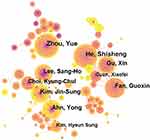Back to Journals » Journal of Pain Research » Volume 16
Research Trends of Percutaneous Endoscopic Lumbar Discectomy in the Treatment of Lumbar Disc Herniation Over the Past Decade: A Bibliometric Analysis
Authors Zhang Y , Chu J , Xia Y, Xie Y, Zhang R, Chen X, Chen Z, Yao X
Received 18 May 2023
Accepted for publication 27 September 2023
Published 4 October 2023 Volume 2023:16 Pages 3391—3404
DOI https://doi.org/10.2147/JPR.S421837
Checked for plagiarism Yes
Review by Single anonymous peer review
Peer reviewer comments 3
Editor who approved publication: Professor Krishnan Chakravarthy
Yang Zhang,1,2,* Jiahao Chu,2,* Yunfan Xia,2 Yuepeng Xie,1 Ruikun Zhang,2 Xiaogang Chen,1 Zhineng Chen,1 Xinmiao Yao1,2
1The Third Affiliated Hospital of Zhejiang Chinese Medical University, Hangzhou, Zhejiang, People’s Republic of China; 2The Third Clinical Medical College of Zhejiang Chinese Medical University, Hangzhou, Zhejiang, People’s Republic of China
*These authors contributed equally to this work
Correspondence: Xinmiao Yao, Department of Orthopedics, the Third Affiliated Hospital of Zhejiang Chinese Medical University, 219 Moganshan Road, Xihu District, Hangzhou, Zhejiang, People’s Republic of China, Tel +86 571-87238254, Fax +86 571-87238005, Email [email protected]
Objective: This study aimed to explore the research trends of percutaneous endoscopic lumbar discectomy in treating lumbar disc herniation using bibliometrics over the past ten years.
Methods: Relevant publications on the clinical application of percutaneous endoscopic lumbar discectomy in lumbar disc herniation were searched in the Web of Science Core Collection. Subsequently, the characteristics of all these articles were collected. Visualizing data of annual publications, journals, cited journals, authors, cited authors, countries, institutions, keywords, and cited references was performed by using CiteSpace (6.1.R6).
Results: A total of 642 publications were extracted between 2013 and 2022. The number of publications peaked in the year 2020. The most prolific journal was World Neurosurgery (81), and Spine (597) as the cited journal was the most popular one. China (393) was the most prolific country, followed by South Korea (100). The institution with the most productivity was Tongji University (35). Yue Zhou (20) was the most prolific author, and Sebastian Ruetten (310) was the most cited author. The keyword “interlaminar” was top of research developments with the highest citation burst (8.69). “Lumbar disc herniation”, “surgical technique”, and “complication” were popular keywords. The surgical procedures and complications of percutaneous endoscopic lumbar discectomy have been the hot topics of recent research.
Conclusion: This study summarized the current situation and development trends of percutaneous endoscopic lumbar discectomy clinical research in the form of visualization, and these findings may help researchers explore new directions in the future.
Keywords: percutaneous endoscopic lumbar discectomy, lumbar disc herniation, bibliometric analysis, complication
Introduction
With the accelerating pace of people’s work and life, the number of people suffering from lumbar disc herniation is increasing yearly. And its incidence was as high as 7.62% in China.1 Percutaneous endoscopic lumbar discectomy (PELD), with less trauma and fast recovery, has been a favorable alternative to open discectomy for patients of lumbar disc herniation.2 The indication for PELD has been expanded through improved techniques.3 PELD, a minimally invasive spine surgery, has been a mainstream technique for lumbar disc herniation.4 Some studies suggested a similar incidence of recurrence between PELD and open discectomy or microendoscopic discectomy (MED).5–7 But others reported that PELD had a higher reoperation rate than open surgery.8 Even so, PELD is widely used by many surgeons for patients with lumbar disc herniation.
Bibliometric is a statistical and quantitative analysis of publications. It can identify the relationship between authors, institutions, journals, references, and countries and show research trends by integrating visualization information.9 CiteSpace is a commonly used software that can visualize and analyze emerging trends in publications.10 To address the shortage of quantitative analysis of the research on PELD, we aimed to provide a visualization for the global scientific research on PELD by taking advantage of bibliometrics. To the best of our knowledge, there is no bibliometric analysis on PELD with CiteSpace yet. Therefore, it is necessary to analyze the articles in the last decade to reveal the current trend of PELD research. In this study, the publications in PELD research between 2013 and 2022 were selected, and the characteristics were analyzed.
Methods
Search Strategy
All data in this study were obtained from WoS Core Collection, including Science Citation Index Expanded, Social Sciences Citation Index, Arts & Humanities Citation Index, Conference Proceedings Citation Index - Science, Conference Proceedings Citation Index - Social Science & Humanities, Book Citation Index - Science, Book Citation Index - Social Sciences & Humanities, Emerging Sources Citation Index, Current Chemical Reactions and Index Chemicus, on January 2, 2023. Data search strategies included the topic “Percutaneous Endoscopic Lumbar Discectomy” and “lumbar disc herniation”, with a published period from 2013 to 2022. In addition, there are no restrictions on the country or language of publication. The specific search strategies and results are listed in Table 1.
 |
Table 1 The Topic Search Query |
Article Screening
A total of 660 results were found and sorted according to the document types. After the CiteSpace format conversion, 2 corrections, 6 editorial materials, and 10 letters were excluded. Finally, 642 publications were included in the analysis. The specific search strategy and procedure are shown in Figure 1.
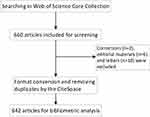 |
Figure 1 Flowchart of the searching and screening of articles. |
Data Extraction
A whole of the articles was derived from the Web of Science (WoS) Core Collection and relative information was extracted. Author information could be used to clarify the prolific authors, institutions, and countries. Article information could reveal the relationship between keywords and hot topics. Meanwhile, publication and citation information could identify the publication years, cited times, prolific journals, and popular references.
Visualized Analysis
Files that involved the above-mentioned information of the articles were exported from the WoS website and imported into CiteSpace 6.1.R6 and Microsoft Excel. CiteSpace parameters were set as followed: (1) time slicing: from 2013 January to 2022 December, and per slice chose 1 year. (2) term source: all options were ticked, including “title, abstract, author keywords, keywords plus”. (3) selection criteria: factor k = 25. (4) pruning: pathfinder, pruning sliced networks, and pruning merged networks were selected. Every item, like author, journal, keyword, and so on, was shown on the map as a node. The size of the node reflected the frequency of every element. The diverse colors of the node meant different years. The purple circle meant centrality, and nodes with high centrality were usually regarded as critical points in a specific field. Besides, links between the nodes suggested the relationships of co-occurrence or co-citation.
Results
Annual Publications
A total of 642 articles were selected after searching and screening in WoS. The exact number of annual publications is shown in Figure 2. The graph indicates that the number of publications on PELD in treating lumbar disc herniation reveals a general trend of rapid increase over the past 10 years. From 2015 to 2016, there was a sharp increase from 18 publications to 55 publications. The number of publications was stable from 2018 to 2019. And the number of publications peaked in 2020, with 110 publications. From 2021 to 2022, there was a mild reduction from 108 publications to 95 publications. The number of publications in productive countries, like China and South Korea, fluctuated and showed an overall upward trend.
 |
Figure 2 The number of annual publications from 2013 to 2022. |
Journals and Cited Journal
These articles were published in 132 journals, of which the top 10 were shown in Table 2. World Neurosurgery was the most prolific journal, with 81 articles, followed by Pain Physician with 65. Their impact factors (IF) were 2.0 and 3.7 in 2022, respectively. The map of cited journals (Figure 3) was generated by CiteSpace software, and Spine had the highest number of citations with 597. The circle size showed the number of cited times, while the links between the circles represented the relationship between cited journals. And the line thickness represents the relationship strength. Among the top 10 cited journals (Table 3), the Journal of Bone and Joint Surgery-American Volume has the highest IF in 2022 (5.3), followed by Neurosurgery (4.8) and Spine Journal (4.5).
 |
Table 2 Top 10 Journals Related to PELD for Lumbar Disc Herniation |
 |
Table 3 Top 10 Cited Journals Related to PELD for Lumbar Disc Herniation |
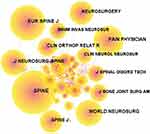 |
Figure 3 Cited journal map related to PELD for lumbar disc herniation from 2013 to 2022. |
A dual-map overlay with citing and cited matrices of journals was generated by using CiteSpace 6.1.R6 software (Figure 4). Citing journals are displayed on the left of the dual-map, while the right side means cited journals. And there are 3 citation paths in this illustration. These 3 paths indicate that articles published in “neurology, sports, ophthalmology” journals tended to cite journals mainly in the domains of “health, nursing, medicine”, “sports, rehabilitation, sport” and “psychology, education, social”.
 |
Figure 4 A dual map overlay of journals related to PELD for lumbar disc herniation from 2013 to 2022. |
Authors and Cited Authors
The authors of the publications were analyzed and resulted in 387 nodes and 782 links (Figure 5). The most prolific authors were Yue Zhou, from the Affiliated Xinqiao Hospital of the Third Military Medical University, with 20 articles. Shisheng He and Guoxin Fan followed, with 19 and 16 articles, respectively. The top 10 prolific authors were presented in Table 4. Half of them come from China, while another half come from South Korea.
 |
Table 4 The Top 10 Authors Related to PELD for Lumbar Disc Herniation |
The cited author’s map consisted of 520 nodes and 1662 connecting lines. The most cited author is Sebastian Ruetten, with 310 cited times. The other highly cited authors were Yong Ahn (293), Kyung-Chul Choi (247), Gun Choi (233), and Anthony Tung Yeung (225) (Figure 6). The top 5 centrality of cited authors were Marco Teli (0.32), Yunus Aydin (0.21), Frank U. Hermantin (0.20), Jeong-Mok Kim (0.20) and Martin Barth (0.16) (Table 5).
 |
Table 5 Top 5 Frequency and Centrality of Cited Authors Related to PELD for Lumbar Disc Herniation |
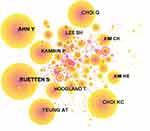 |
Figure 6 Map of cited authors related to PELD for lumbar disc herniation from 2013 to 2022. |
Distribution of Countries and Institutions
There were 45 nodes and 88 links on the distribution of countries or regions map (Figure 7). China had the highest contribution with 393 articles, followed by South Korea (100) and the United States (52). The top 10 publications of countries or regions were shown in Table 6.
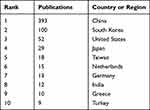 |
Table 6 Top 10 Publications of Countries or Regions Related to PELD for Lumbar Disc Herniation |
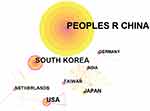 |
Figure 7 Map of countries or regions researching PELD for lumbar disc herniation from 2013 to 2022. |
There were 263 nodes and 261 links on the distribution of institutions map (Figure 8). The research institution with the highest contribution was Tongji University, with 35 articles. Capital Medical University and Catholic University of Korea had 20 and 17 articles, respectively. The top 5 centrality of institutions were Tongji University (0.18), Artificial Intelligence Innovation Center (0.18), Sun Yat-sen University (0.16), Dayeh University (0.16) and Army Medical University (0.15). And the top 10 publications of institutions were displayed in Table 7.
 |
Table 7 Top 10 Publications and Centrality of Institutions Related to PELD for Lumbar Disc Herniation |
 |
Figure 8 Map of institutions researching PELD for lumbar disc herniation from 2013 to 2022. |
Keywords
370 keywords appeared in the analysis, which were shown in the keyword map with 1316 links (Figure 9). Combining frequency with centrality, it showed that mainstream keywords were “lumbar disc herniation”, “surgical technique”, “microdiscectomy”, “interlaminar approach”, “pain”, “complication”, “foraminal stenosis”, and “classification” (Table 8). The top 20 keywords with the strongest citation bursts between 2013 and 2022 were shown in Figure 10. The most recent burst Keywords were “lateral recess stenosis”, “instability”, “percutaneous endoscopic transforaminal discectomy” and “percutaneous endoscopic interlaminar discectomy”. The keyword “interlaminar” had a strength citation burst of 8.69, followed by “surgical technique” (4.93), and “percutaneous endoscopic transforaminal discectomy” (3.81).
 |
Table 8 The Top 10 Keywords with the Highest Frequency and Centrality Related to PELD for Lumbar Disc Herniation |
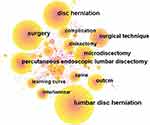 |
Figure 9 Map of keywords researching PELD for lumbar disc herniation from 2013 to 2022. |
 |
Figure 10 Top 20 keywords with the strongest citation bursts. The red bar shows the keyword was highly cited, while the green bar represents the keyword was in low frequency. |
Cited References
When two articles were cited by another article at the same time, they have a relationship of co-citation. The relationships between cited references were shown in Figure 11. The top 5 frequency and centrality of cited references were listed in Table 9 and Table 10. A retrospective study published by Choi KC in 2016 got the highest co-citation times, followed by his other study in 2015 and a study of Liu XY in 2018. Choi KC compared the outcomes of large lumbar disc herniation treated with percutaneous endoscopic lumbar discectomy and open lumbar microdiscectomy, and believed that PELD could be as effective as open lumbar microdiscectomy.11 And he concluded that main causes of unsuccessful PELD were incomplete removal of herniated discs, recurrence, persistent pain even after complete removal and approach-related pain, by performing a review on 10,228 patients.5 The article with the highest centrality was published by Du JW in 2016, illustrating that PELD via a translaminar approach could be safe and effective for the treatment of soft, highly down-migrated lumbar disc herniation.
 |
Table 9 The Top 5 Frequency of Cited References Related to PELD for Lumbar Disc Herniation |
 |
Table 10 The Top 5 Centrality of Cited References Related to PELD for Lumbar Disc Herniation |
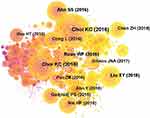 |
Figure 11 Map of cited references related to PELD for lumbar disc herniation from 2013 to 2022. |
In this study, CiteSpace 6.1.R6 software was used to perform cluster analysis on cited references, to acquire pivotal information and explore research trends from cited references. The logarithmic likelihood ratio (LLR) algorithm was applied to assess nominal terms extracted from the keywords. A map of 20 clusters was made with a modularity value of 0.8094, which meant the results were quite reliable. The top 7 clusters were “migrated disc herniation”, “sciatica”, “radiation”, “microendoscopic discectomy”, “percutaneous endoscopic lumbar discectomy”, “early recurrence”, “percutaneous lumbar disc decompression” (Figure 12).
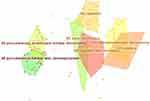 |
Figure 12 Top 7 clusters of cited references related to PELD for lumbar disc herniation from 2013 to 2022. |
Discussion
In the present study, we extracted 642 related articles from the WOS core collection database between 2013 and 2022. Bibliometric analysis was utilized to probe the characteristics of the PELD in lumbar disc herniation from various perspectives in this field by using CiteSpace 6.1.R6 software. All these findings may have impacts on the research in the following studies.
PELD provides equivalent curative effects for treating lumbar disc herniation compared with open lumbar microdiscectomy.14,20,21 PELD shows advantages in less tissue damage, less intraoperative blood loss, and fast postoperative recovery.20,22 Besides, PELD can be performed under local anesthesia.23,24 Because of these unique advantages, PELD has been a burgeoning technology in the recent decade, especially in China and South Korea. In terms of this study, the number of articles has increased dramatically since 2016. The publications of China have made up over half every year since 2016. Consequently, this technique has developed rapidly and has been widely applied by surgeons around China since 2016.
The visualized analysis clearly presented a network of relationships between the high-impact institutions and authors. Most of the top ten prolific authors stemmed from the top five institutions with the most contributions, and they were all from China and South Korea. Tongji University ranked first in both the publications and the centrality, which occupied an important position in the clinical application of PELD. As seen from Figure 8, there were few connections between large nodes representing prolific institutions, which meant that studies between high-impact institutions were relatively independent. More multicenter studies will be published if these prolific institutions cooperate, which are of higher value.
In this study, most of the top 10 journals were orthopedic and neurosurgery specialty journals, with at least 15 publications (Table 2). The impact factor of these journals was between 1.6 and 3.7. Thus, these results suggested that most articles on PELD were published in specialty journals. At the same time, there was a lack of highly scholarly impact journals in this field. As an essential indicator, citations can evaluate the academic impact of publications. The highly cited journals were also more likely to be orthopedic and neurosurgery specialty journals, such as Spine, Journal of Bone and Joint Surgery, Neurosurgery, and Spine Journal. It is obvious that American journals were dominating in cited journals of research about PELD. The dual map (Figure 4) showed that citing journals focus on the field of “Neurology, sports, ophthalmology”. And cited journals are mainly in the domains of “health, nursing, medicine”, “sports, rehabilitation, sport” and “psychology, education, social”, which is in accord with the results in Table 3.
We analyzed co-occurrence and burst of keywords to explore the research trends of PELD. Keywords are commonly used to catch the hot topics of publications in recent years. Besides, cited references were clustered according to keywords to find the major topics. The main keywords of these articles were presented in the visualized analysis (Figure 9). As we expected, “lumbar disc herniation” was mentioned most often. And keywords about surgical procedures, like “microdiscectomy”, “surgical technique”, “interlaminar”, and “decompression”, gained a lot of interest. In addition to keywords related to the surgery, the terms “complication”, “instability”, “outcome”, and “learning curve” pointed to the focus of PELD for lumbar disc herniation (Figures 9 and 10). The top 7 clusters of cited references reflected that topics of surgical technique (“radiation”, “microendoscopic discectomy”, “percutaneous endoscopic lumbar discectomy”, and “percutaneous lumbar disc decompression”), pathological characteristics (“migrated disc herniation” and “sciatica”) and complication (“early recurrence”) were given a lot of attention.
As we know, the selection and establishment of the surgical approach are crucial for PELD.25,26 In two articles by Sebastian Ruetten, the most cited author, there were two commonly used approaches of PELD surgery for lumbar disc herniation or recurrent lumbar disc herniation after conventional discectomy, percutaneous endoscopic interlaminar discectomy (PEID) and percutaneous endoscopic transforaminal discectomy (PETD).27,28 PEID is better to deal with disc herniation of L5/ S1 than PETD. Highly migrated and calcified disc herniation are also indications of PEID. However, PETD is much safer than PEID, which may lead to dural laceration and other complications.29 With the development of this technology, it was emphasized that PELD had some limitations. Apart from common complications, Zhou reported that unique complications of PELD contained passage of the working channel through the spinal canal, super-elastic nerve hook caught by exiting nerve root, epidural hematoma, radicular artery injury, and intraoperative seizure.30 Yin concluded that the rate of PELD recurrence was 3.6%, and it usually occurred within 6 months postoperatively. Older age, obesity, upper lumbar disc and central disc herniation were independent risk factors for recurrence after PELD recurrent herniation.31 Consequently, reasonable indications, proficiency improvement, and selection of appropriate surgical approach are the keys to reducing complications and recurrence rates.
To some extent, proficiency in minimally invasive procedures can reduce postoperative complications in PELD. However, PELD has a rather long learning curve, which was also a high-frequency keyword in this study. The learning curve is a process of meeting a predefined level of performance with increasing experience and training. The surgical technique of PELD has a steep learning curve, especially for complex cases.32 Wu compared the learning curves of the transforaminal approach of PELD at different levels (L4/5 and L5/S1) and suggested the technique of transforaminal approach at the L4/5 level may be easier to be mastered.33 To research the learning curve of PELD, some professors conducted comparative studies. Sun concluded that prior experience with selective nerve root block could help novice surgeons shorten operation time and reduce the complication rate.34 With the assistance of an O-arm-based navigation system, Ao found that it reshaped the learning curve of PELD, increased the accuracy of puncture, and minimized radiation exposure.35 The accumulation of surgeons’ experience, the update of equipment, and the innovation of techniques are significant in reducing the complications of PELD. Therefore, the surgical procedures and complications of PELD have been the hot topics of recent research and still will be the trends in the future.
Limitations
The selected articles in this study were only from the WoS Core Collection. Some articles of high value about PELD may be omitted from other databases. Time sequence and self-citation may impact citation times to a certain degree. Nevertheless, we believe these articles could reflect the general state and trend of PELD research.
Conclusion
The PELD in treating lumbar disc herniation is a relatively developed technique, with a notable increase in the 2010s. In this study, scholars from hospitals or universities in China, South Korea, and the United States made great contributions to this technique. World Neurosurgery was the most prolific journal, and Spine was the most influential journal in the field of PELD. Most articles focused on the surgical procedures and complications of PELD, which also will get more attention in the future.
Acknowledgment
Thanks to Prof. Chaomei Chen for the availability of CiteSpace.
Funding
This work was supported by Traditional Chinese Medicine Project of Science and Technology Planning Commission of Zhejiang Province (No. 2023ZL075). The trial sponsor is the Third Affiliated Hospital of Zhejiang Chinese Medicine University (219 Moganshan Road, Xihu District, Hangzhou City, Zhejiang Province 310005, China, 86-571-88393504).
Disclosure
The authors declare that there is no conflict of interest regarding the publication of this paper.
References
1. Meng Z, Zheng J, Fu K, Kang Y, Wang L. Curative effect of foraminal endoscopic surgery and efficacy of the wearable lumbar spine protection equipment in the treatment of lumbar disc herniation. J Healthc Eng. 2022;2022:6463863. doi:10.1155/2022/6463863
2. Ahn Y. A historical review of endoscopic spinal discectomy. World Neurosurg. 2021;145:591–596. doi:10.1016/j.wneu.2020.08.008
3. Choi KC, Shim HK, Lee DC, Park CK. Intraoperative disc prolapse during percutaneous endoscopic lumbar discectomy. World Neurosurg. 2019;123:81–85. doi:10.1016/j.wneu.2018.11.216
4. Yu Z, Lu Y, Li Y, An Y, Wang B. A one-step foraminoplasty via a large trephine in percutaneous endoscopic transforaminal discectomy for the treatment of lumbar disc herniation. PLoS One. 2022;17(5):e0268564. doi:10.1371/journal.pone.0268564
5. Choi KC, Lee JH, Kim JS, et al. Unsuccessful percutaneous endoscopic lumbar discectomy: a single-center experience of 10,228 cases. Neurosurgery. 2015;76(4):372–380. doi:10.1227/NEU.0000000000000628
6. Li X, Han Y, Di Z, et al. Percutaneous endoscopic lumbar discectomy for lumbar disc herniation. J Clin Neurosci. 2016;33:19–27. doi:10.1016/j.jocn.2016.01.043
7. Xu J, Li Y, Wang B, et al. Minimum 2-year efficacy of percutaneous endoscopic lumbar discectomy versus microendoscopic discectomy: a meta-analysis. World Neurosurg. 2020;138:19–26. doi:10.1016/j.wneu.2020.02.096
8. Cheng J, Wang H, Zheng W, et al. Reoperation after lumbar disc surgery in two hundred and seven patients. Int Orthop. 2013;37(8):1511–1517. doi:10.1007/s00264-013-1925-2
9. Li C, Wang L, Perka C, Trampuz A. Clinical application of robotic orthopedic surgery: a bibliometric study. BMC Musculoskelet Disord. 2021;22(1):968. doi:10.1186/s12891-021-04714-7
10. Chen C. Searching for intellectual turning points: progressive knowledge domain visualization. Proc Natl Acad Sci U S A. 2004;1:5303–5310. doi:10.1073/pnas.0307513100
11. Choi KC, Kim JS, Park CK. Percutaneous endoscopic lumbar discectomy as an alternative to open lumbar microdiscectomy for large lumbar disc herniation. Pain Phys. 2016;19(2):E291–300. doi:10.36076/ppj/2016.19.E291
12. Liu X, Yuan S, Tian Y, et al. Comparison of percutaneous endoscopic transforaminal discectomy, microendoscopic discectomy, and microdiscectomy for symptomatic lumbar disc herniation: minimum 2-year follow-up results. Journal of Neurosurgery: Spine. 2018;28(3):317–325. doi:10.3171/2017.6.SPINE172
13. Ahn SS, Kim SH, Kim DW, Lee BH. Comparison of outcomes of percutaneous endoscopic lumbar discectomy and open lumbar microdiscectomy for young adults: a retrospective matched cohort study. World Neurosurg. 2016;86:250–258. doi:10.1016/j.wneu.2015.09.047
14. Ruan W, Feng F, Liu Z, Xie J, Cai L, Ping A. Comparison of percutaneous endoscopic lumbar discectomy versus open lumbar microdiscectomy for lumbar disc herniation: a meta-analysis. Int Surg J. 2016;31:86–92. doi:10.1016/j.ijsu.2016.05.061
15. Du J, Tang X, Jing X, Li N, Wang Y, Zhang X. Outcomes of percutaneous endoscopic lumbar discectomy via a translaminar approach, especially for soft, highly down-migrated lumbar disc herniation. Int Orthop. 2016;40(6):1247–1252. doi:10.1007/s00264-016-3177-4
16. Gadjradj PS, Harhangi BS. Percutaneous transforaminal endoscopic discectomy for lumbar disk herniation. Clin Spine Surg. 2016;29(9):368–371. doi:10.1097/BSD.0000000000000366
17. Ahn Y. Percutaneous endoscopic decompression for lumbar spinal stenosis. Expert Rev Med Devices. 2014;11(6):605–616. doi:10.1586/17434440.2014.940314
18. Choi G, Kang HY, Modi HN, et al. Risk of developing seizure after percutaneous endoscopic lumbar discectomy. J Spinal Disord Tech. 2011;24(2):83–92. doi:10.1097/BSD.0b013e3181ddf124
19. Wang K, Hong X, Zhou BY, et al. Evaluation of transforaminal endoscopic lumbar discectomy in the treatment of lumbar disc herniation. Int Orthop. 2015;39(8):1599–1604. doi:10.1007/s00264-015-2747-1
20. Yu H, Zhu B, Liu X. Comparison of percutaneous endoscopic lumbar discectomy and open lumbar discectomy in the treatment of adolescent lumbar disc herniation: a retrospective analysis. World Neurosurg. 2021;151:e911–e917. doi:10.1016/j.wneu.2021.05.007
21. Qin R, Liu B, Hao J, et al. Percutaneous endoscopic lumbar discectomy versus posterior open lumbar microdiscectomy for the treatment of symptomatic lumbar disc herniation: a systemic review and meta-analysis. World Neurosurg. 2018;120:352–362. doi:10.1016/j.wneu.2018.08.236
22. Jarebi M, Awaf A, Lefranc M, Peltier J. A matched comparison of outcomes between percutaneous endoscopic lumbar discectomy and open lumbar microdiscectomy for the treatment of lumbar disc herniation: a 2-year retrospective cohort study. Spine J. 2021;21(1):114–121. doi:10.1016/j.spinee.2020.07.005
23. Lv Z, Jin L, Wang K, et al. Comparison of Effects of PELD and fenestration in the treatment of geriatric lumbar lateral recess stenosis. Clin Interv Aging. 2019;14:2187–2194. doi:10.2147/CIA.S226295
24. Chen Z, Wang X, Cui X, Zhang G, Xu J, Lian X. Transforaminal versus interlaminar approach of full-endoscopic lumbar discectomy under local anesthesia for L5/S1 disc herniation: a randomized controlled trial. Pain Phys. 2022;25(8):E1191–e1198.
25. Choi KC, Kim JS, Ryu KS, Kang BU, Ahn Y, Lee SH. Percutaneous endoscopic lumbar discectomy for L5-S1 disc herniation: transforaminal versus interlaminar approach. Pain Phys. 2013;16(6):547–556.
26. Chen B, Du Z. Neurological safety of spinal surgery for nucleus pulposus removal under spinal endoscopic imaging guided by inter laminar spine. Pak J Med Sci. 2021;37(6):1667–1671. doi:10.12669/pjms.37.6-WIT.4880
27. Ruetten S, Komp M, Merk H, Godolias G. Full-endoscopic interlaminar and transforaminal lumbar discectomy versus conventional microsurgical technique: a prospective, randomized, controlled study. Spine. 2008;33(9):931–939. doi:10.1097/BRS.0b013e31816c8af7
28. Ruetten S, Komp M, Merk H, Godolias G. Recurrent lumbar disc herniation after conventional discectomy: a prospective, randomized study comparing full-endoscopic interlaminar and transforaminal versus microsurgical revision. J Spinal Disord Tech. 2009;22(2):122–129. doi:10.1097/BSD.0b013e318175ddb4
29. Pan M, Li Q, Li S, et al. Percutaneous endoscopic lumbar discectomy: indications and complications. Pain Phys. 2020;23(1):49–56.
30. Zhou C, Zhang G, Panchal RR, et al. Unique complications of percutaneous endoscopic lumbar discectomy and percutaneous endoscopic interlaminar discectomy. Pain Phys. 2018;21(2):E105–e112.
31. Yin S, Du H, Yang W, Duan C, Feng C, Tao H. Prevalence of recurrent herniation following percutaneous endoscopic lumbar discectomy: a meta-analysis. Pain Phys. 2018;21(4):337–350.
32. Sun B, Shi C, Xu Z, et al. Learning curve for percutaneous endoscopic lumbar diskectomy in bi-needle technique using cumulative summation test for learning curve. World Neurosurg. 2019;129:e586–e593. doi:10.1016/j.wneu.2019.05.227
33. Wu XB, Fan GX, Gu X, et al. Learning curves of percutaneous endoscopic lumbar discectomy in transforaminal approach at the L4/5 and L5/S1 levels: a comparative study. J Zhejiang Univ Sci B. 2016;17(7):553–560. doi:10.1631/jzus.B1600002
34. Sun B, Wu H, Xu Z, et al. Is selective nerve root block necessary for learning percutaneous endoscopic lumbar discectomy: a comparative study using a cumulative summation test for learning curve. Int Orthop. 2020;44(7):1367–1374. doi:10.1007/s00264-020-04558-1
35. Ao S, Wu J, Tang Y, et al. Percutaneous endoscopic lumbar discectomy assisted by O-arm-based navigation improves the learning curve. Biomed Res Int. 2019;2019:6509409. doi:10.1155/2019/6509409
 © 2023 The Author(s). This work is published and licensed by Dove Medical Press Limited. The full terms of this license are available at https://www.dovepress.com/terms.php and incorporate the Creative Commons Attribution - Non Commercial (unported, v3.0) License.
By accessing the work you hereby accept the Terms. Non-commercial uses of the work are permitted without any further permission from Dove Medical Press Limited, provided the work is properly attributed. For permission for commercial use of this work, please see paragraphs 4.2 and 5 of our Terms.
© 2023 The Author(s). This work is published and licensed by Dove Medical Press Limited. The full terms of this license are available at https://www.dovepress.com/terms.php and incorporate the Creative Commons Attribution - Non Commercial (unported, v3.0) License.
By accessing the work you hereby accept the Terms. Non-commercial uses of the work are permitted without any further permission from Dove Medical Press Limited, provided the work is properly attributed. For permission for commercial use of this work, please see paragraphs 4.2 and 5 of our Terms.

